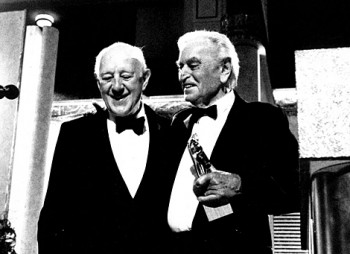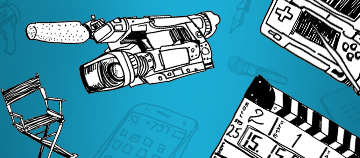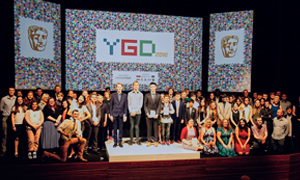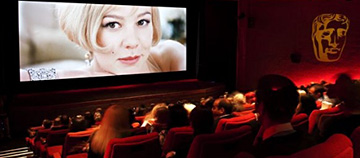 BAFTA Archive
BAFTA Archive George Clarke tells the story of the British Academy and the dedicated, passionate individuals who have ensured its survival.
From informal beginnings to its great current stature
It was in a spirit of genuine 'sow and ye shall reap' altruism that the founders of the Academy first gathered together in the hotel suite of Michael Balcon at the Hyde Park Hotel on 16 April 1947. To understand the raison d'etre of this initial meeting of 13 men and one woman, and why we are celebrating it half a century later, it would be germane to reconstruct the background that existed in the British entertainment industry at the time.
The existence of only 14,000 television sets in the London area proved the medium was not yet a force, and provincial theatre was only sustained by audiences attracted to the long-established music-hall which was seemingly without a future. Films, being 'the folklore of the 20th century', proffered more.
Annual attendances at British cinemas had soared to an all-time high of 1,635 million in 4,710 cinemas, indicating that in spite of darkened front-of-house lighting displays, acute fuel crises, continuing post-war rationing and general austerity, the cinema still offered the most attractive and practical 'escape' possible. The Odeon and Gaumont chains in Britain were overseen by J Arthur Rank, an established producer with great flair and ideas for expansion of the domestic product, who had embarked on a crusade to put British films on an internationally accepted footing. He was encouraged by the worldwide success of Brief Encounter and Great Expectations. He also backed the independent producers' company Cineguild which, in 1948, was preparing Oliver Twist, with Black Narcissus already blooming and The Red Shoes planning to step out.
By the end of 1947, Rank had an interest in 730 overseas cinemas having set up a new company in partnership with Universal Pictures to distribute his own pictures in the lucrative American market. The rival chain, ABC, minus such a potentate, with no overseas outlets and being substantially owned by Warner Brothers, was no threat to Rank despite some successes in the home market (particularly the latest Boulting Brothers' productions of Fame is the Spur and Brighton Rock in 1947). The only potential opposition to Rank's dominance of the British film industry was Alexander Korda.
The Hungarian/British entrepreneur and producer had enjoyed great artistic and financial success in pre-war Britain, but despite An Ideal Husband and Anna Karenina (personages who would break anybody's bank!) was now in the process of re-establishing London Films and Shepperton Studios and battling with the financial difficulties therein. Rank's virtual monopoly had many critics, none more so than Michael Balcon, head of Ealing Studios, which was yet to realise its comedy masterpieces, but was nevertheless obliged to depend on Rank for distribution.
In spite of a mid-40s Board of Trade report, Tendencies to Monopoly in the Cinematograph Film Industry, relating specifically to the extension of power by the Rank Organisation, J Arthur found himself in America busily selling when the British Government intervened, placing a hefty 75 per cent 'value added' tax on American films imported after August 1947. This was to throw the home industry into turmoil. American circuits, as a result, were temporarily closed to British films and America refused to send any new films to Britain. So cinemas were soon reduced to playing re-issues of oldies and extending the runs of new British pictures. Incidentally, this original tax was repealed by the Chancellor of the Exchequer, Sir Stafford Cripps, in May 1948 in exchange for an agreement to stop the removal of earnings from American films in this country over an annual figure of $17 million.
Anything remaining was to be reinvested in British film production. So it was, in this poisoned atmosphere of dubious high film finance and manipulation, that a need was felt for the establishment of a national body which could adequately represent the creative influences in British films.
To satisfy that need, a symposium was arranged in the aforementioned hotel suite in which David Lean, as chairman, elaborated to a cross-section of British filmmakers a few facts and figures for future consideration. These topics were considered again, less stuffily, on 13 May 1947 at Claridge's where the host, Alexander Korda, touched on the subject of films reflecting the international ideal embodied by the United Nations Charter. As the evening progressed, tongues loosened and certain remarks which can only be permitted between intimates were uttered. Carol Reed remarked on how different Hollywood actors were from British actors, most of whom had a theatrical background and Korda reflected on what Charles Laughton meant when he had confessed that he had 'lost it' in a reference to Hollywood spoiling him. Nobody will ever know whether Laughton really lost it or not but, by the dessert, when a cloudlike froth of hot whipped egg-white concealing ice-cream was served, Korda could only reminisce on the whole concoction reminding him of Russian women! Certainly a group at ease with itself, if not yet furthering 'the creative influence in British films'!
That would come later, on 4 November 1947 to be precise, when the same homogeneous group met to decide 'the benefits to be derived from bringing such an organisation into existence'.
The initial step was the appointment of a temporary committee. Anthony Asquith, Michael Balcon, Sir Alexander Korda, Frank Launder, David Lean, Michael Powell, Emeric Pressburger, Carol Reed and Paul Rotha were afforded the power to draft a constitution, to make recommendations regarding the finances of the Academy and to submit for election to said Academy a preliminary list of individuals who, in the opinion of the committee, had contributed outstanding creative work towards the advancement of British film.
The Academy should be non-factional, non-political and whose first aim should be to establish closer co-operation between the creative workers of all categories (feature, documentary, educational, cartoon and news-reel), undertake research, issue publications and give awards for artistic merit. Armed with all these agreements and with a Council of Management elected as above, the discussions of a typical meeting will illustrate the topics raised and how they were faced and dealt with - or not as the case may be - first time around.
Uppermost in these first meetings, naturally enough, was the question of financing the Academy. The Statement of Accounts was usually read aloud by the Secretary General, the first being Doctor Roger Manvell, or occasionally the auditor, A I Todman. At the first meeting on 19 November 1947, the funds of the Academy stood, after payment of October salaries and all bills up to date, at £790.
These funds varied annually but certainly up to April 1954, when a proportion of income could be invested (in Defence Bonds), numbers were invariably recorded in red. Indeed, in the outline of the financial position during the period 1951/52, the Chairman stated categorically that Council had been called to make a decision for or against closing the Academy as the bank only contained sufficient funds to meet current difficulties!
Subsequently, in 1952/53, it was agreed that the Academy should once more prepare a case to the BFPA for extra loans to continue, given that the Academy was 'making every possible effort to increase its revenue by its own efforts.' Unfortunately, these did not include 100 per cent support by its Members who consistently refused to keep up to date with payment of their subs. After January 1948, entrance fees would be introduced and paid by all new members, remaining at £10 until further notice. Members' subscription rates ranged from an annual £2 subscription for a Member earning up to £1,000 per annum to £50 for anyone earning over £10,000 per annum.
So serious was the situation of non-payment that at the Meeting of the Council of Management on 26 November 1952, a list of Members whose subscriptions were outstanding was read aloud and a reminder sent to those who had not paid for two or more years. A slapped wrist to any present Members in the same circumstances - whatever their subscription rate!
Another way of bolstering finance was by voluntary donations from individual (mainly film producing) companies. In 1947, the Rank Organisation committed themselves to an annual subscription to the Academy of £4,000; Ealing Studios to £500; London Films offered £1,000 (generous considering it was being overhauled), which was matched by the Screen-writers' Club and several other less grandiose bodies. A unique contribution of £5 5s 0d came from the Cinematograph Exhibitors Association for 1949. It was agreed that the cheque should be destroyed, and under no circumstances should the CEA again be asked to make a donation to the Academy. So there!
A thorn in the side of the new body was to be one of premises. By December 1947, 7 Deanery Street, London W1, was proving presentation, a fact which, ostensibly at least, records the first time film and television had worked together in this country. Recognition of television had come two years previously when the possibility of presenting an Academy Award for the best television programme on film had been positively discussed. Finally, however, it was decided to only recognise this field of production when the level of achievement in it 'was suitable' for an Academy Award. Ouch!
Up to (and including) the original transmitted on 11 November 1953, Andrew Miller-Jones had pioneered high quality television programmes and had already helped to found the Guild of Television Producers and Directors in order 'to advance the art, science and technique of television production.' In other words, to do for television what the Academy had done, and was continuing to do, for film.
To encourage artistic and professional merit, they held their own awards, for which the American Sculptor Mitzi Cunliffe was persuaded to design the now familiar Grecian maquette, later adopted by BAFTA for its annual awards.
The first of these was held at the Television Ball at the Savoy Hotel on 24 October 1954. There were, in fact, only six awards presented on that memorable evening, but, by the time Edith Evans' role of presenter came to an end seven years later, the number had reached double figures. During this time the quality of the recipients set the standard for the future.
This article, written by George Clark, first appeared in our 1997 Awards publication and celebrates the first half century of the Academy's existence.





